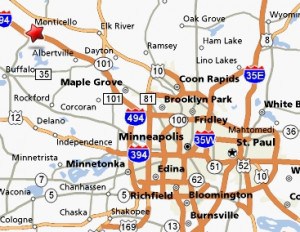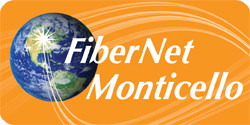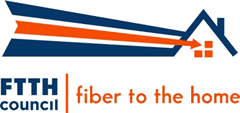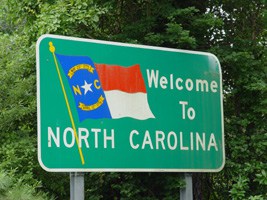
Monticello, Minnesota
A Minnesota Appeals Court panel ruled this week that Internet access is a “utility,” comparable to gas, electric, and telephone service, and not merely a convenience. In a 2-1 decision, the Court ruled in favor of the city of Monticello, which proposed constructing an all-fiber broadband platform reaching every resident, financed by city-issued bonds.
The legislature has granted municipalities the express authority to own and operate telephone exchanges within their borders, as well as to operate public-cable communications systems. Minn. Stat. §§ 237.19, 238.08, subd. 3 (2008). Municipalities are not granted a similar authorization with regard to Internet service; however, the legislature has stated that it is a goal to “encourage economically efficient deployment of infrastructure for higher speed telecommunication services and greater capacity for voice, video, and data transmission.” Minn. Stat. § 237.011 (2008).
Bridgewater concedes that telephone services are utilities and that television services are a gray area, but steadfastly denies that Internet services qualify as a utility. Therefore, according to Bridgewater, the project in its entirety lacks statutory authority to be funded by revenue bonds because Monticello intends to provide Internet service. Based on the aforementioned statute, there appears to be minimal dispute that telephone and cable television are utilities. The crux of the issue is whether broadband Internet service is like a utility.
The definition of municipal public utilities appears broad enough to contemplate Internet service. Internet service could arguably be considered a utility under telecommunications related services. Bridgewater argues that related services means services related to providing cable television, such as on-demand movies. However, cable-television companies often provide Internet services. Therefore, on-demand movies, digital video recorders, and Internet service could also be considered related services under the statute. Furthermore, Merriam Webster dictionary defines telecommunication as “communication at a distance (as by telephone).” Internet service seems to meet this definition. E-mail, instant messaging, and talking via web-cam are all ways to communicate at a distance utilizing Internet service. Based on the foregoing definition, the Fiber Project is arguably a utility.
Bridgewater argues that Internet service cannot be considered a utility because it does not have the near universal usage common to a utility. This argument is flawed. As noted by Monticello, ―[i]t would be absurd to conclude that the Minnesota Legislature [would allow revenue bonds] to be used only to fund the creation of systems that provide services that already are in universal or near-universal use. Rather, it seems that the reasoning behind allowing municipalities to issue these bonds is to provide utility-like services to people who otherwise would not be able to enjoy the benefits of the services offered. It is illogical to conclude that something is or is not a utility based on the number of people who have access to it.
Providing an entire community of people with access to telephone services, cable television, and high-speed Internet seems to qualify as a benefit to the public under the changing conditions of modern life. Thus, the Fiber Project is a public convenience that also serves a public purpose.
The Fiber Project qualifies as a public convenience, and therefore revenue bonds can be issued to finance its creation. Although Monticello cannot use the bond money to pay current expenses, the district court did not err in dismissing Bridgewater‘s complaint.

The Municipal-Owned Network
Monticello elected to construct the network after being repeatedly bypassed by private providers for state-of-the-art broadband access. Stuck in a broadband backwater, the community of 11,000 decided to construct an advanced fiber network to reach every resident, and allow any company access to the network. Bridgewater Telephone, the local telephone company owned by TDS, had steadfastly refused requests from city officials to move towards fiber on their own, and after 74% of local voters thought a municipal fiber network was their only hope of getting fiber into their community, the phone company sued to stop it.
TDS claimed the Internet was not a utility and, although the project does not rely on taxpayer funds, still involved a local municipality competing against a private business.
Since the lawsuit, and the threat of competition from Fibernet Monticello, the phone company announced it, too, would construct a fiber network. Meanwhile, while it uses legal maneuvers to keep the municipal network at bay, the costs for the municipality mount. The legal finding noted:
Monticello is losing a substantial amount of money each day that litigation delays installation of the Fiber Network. One estimate is $2,730,268 lost for an 11-month elay. Moreover, placing the bond proceeds in escrow required that the city pay the bond purchasers interest on the bonds until the escrow is released. As a result, Monticello will be required to pay the bondholders approximately $85,000 for every month the lawsuit continues.
Bridgewater’s current broadband DSL service is slow and expensive, after the promotions expire:
Up to 768kbps $29.95
Up to 1.5Mbps $39.95
Up to 4Mbps $49.95
Up to 10Mbps $59.95
Now that the phone company is installing fiber, they are marketing a 25Mbps service for $69.95 a month, with a one year commitment.
Fibernet Monticello’s network has been stalled by the lawsuit, but the municipality suggests it will market residential broadband service at 10 to 100Mbps symmetrical speeds, as well as video and telephone service bundles, with no contract commitment at highly competitive prices. No caps either.
TDS lamented the decision. Drew Petersen, director of legislative affairs and corporate communications released a statement:
“TDS is a job-producing, tax-paying company with millions of dollars invested in the state of Minnesota and the community of Monticello. The Appeals Court decision sends a chilling message to the private business community operating in the state of Minnesota. The decision will likely discourage other private enterprises from doing or expanding their business in Minnesota. Further, the decision endangers the appropriate relationship between municipalities and private enterprise; it also allows municipalities tax-free financing to enter into competition with tax-paying businesses.
“Throughout the legal debate, TDS has been honest in discussions with city leaders and the public. TDS has also invested millions of dollars and, in less than a year, placed 74 miles of fiber in protective conduit to build a complete fiber network covering the entire city. Every resident in the city can receive TDS’ Internet service, via fiber, at speeds of 25 Mbps at value-based prices. The neighboring townships also enjoy speeds above 10 Mbps.
Petersen called TDS’ broadband products in Monticello “blazing fast,” although whether those speeds would have been achieved without Monticello moving forward on its own fiber project is doubtful.
In the view of Stop the Cap!, Petersen has it entirely backwards. Without the competitive threat the municipality represented with its own fiber network, TDS would have been content with the network they felt was good enough for the community for years. TDS repeatedly denied local officials’ requests for fiber, something that we believe only became an option the moment competition was imminent. In the end, with the reality of fiber looming, TDS was hardly discouraged from investing — they were encouraged, at the risk of losing customers in droves to a superior product offered at what likely would be substantially lower pricing.
Municipal broadband networks are often the only weapon communities have from being dumped into a broadband backwater, where speeds are kept slow, prices high, Cap ‘n Tier common, and infrastructure upgrades rare. Be it in Minnesota or North Carolina, communities are told “no” to requests to deploy state-of-the-art networks. That answer frequently changes to “yes” the moment competition threatens to arrive. That’s why big telecommunications companies see fit to use the courts and legislative system to ban, stall, or limit the potential for municipalities to decide what’s best for their residents, limiting them to what one or two companies provide and claim is “good enough.”
(Thanks to Stop the Cap! reader Greg, who notified us of the court decision.)


 Subscribe
Subscribe

 In the last two installments I covered the North Carolina legislators that had a hand in HB1252/S1004, legislation that would have severely curtailed municipal broadband projects in this state, and how they were involved in bringing the bills to the floor.
In the last two installments I covered the North Carolina legislators that had a hand in HB1252/S1004, legislation that would have severely curtailed municipal broadband projects in this state, and how they were involved in bringing the bills to the floor.

